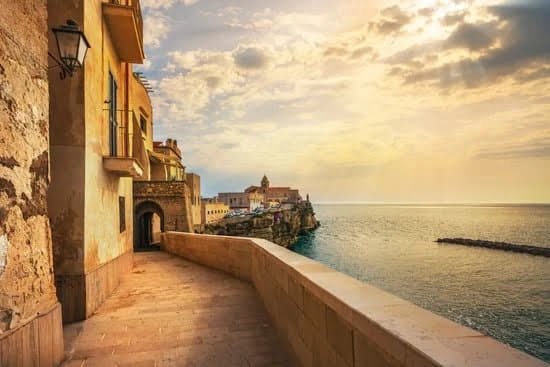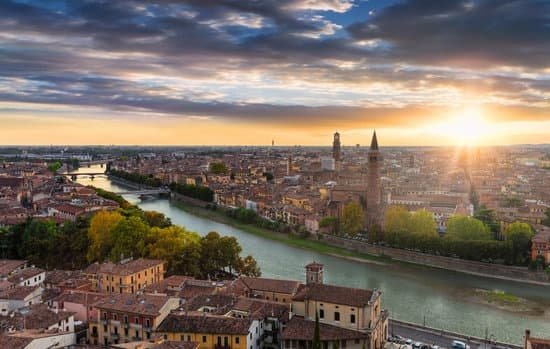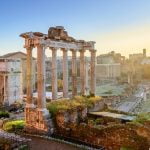
Unesco World Heritage Sites in Italy are a way to celebrate the country’s history, culture, and architecture. Established by United Nations Educational, Scientific and Cultural Organization (UNESCO) in 1972, the World Heritage List aims to identify and protect sites around the world that represent universal values. It recognizes places that illustrate significant achievements of human creativity, from manuscript libraries to ancient fortresses to works of nature like mountains or coral reefs.
Italy is currently home to 55 Unesco-inscribed properties. These range from ports and shipyards to ancient cities and archaeological areas.
The 55 Unesco World Heritage Sites located throughout Italy are reflective of various cultures and geographies throughout the decades. For instance, well-known sites like the historic city of Venice demonstrate the presence of an impressive commercial port in Norman times; while Piazza del Duomo in Florence celebrates Renaissance artisanship through its impressive marble facades and gilded bronze statues depicting religious figures.
Additionally, Val d’Orcia showcases Italy’s dramatic landscape with rolling hills lined by farms and villas, while Cinque Terre highlights romantic fishing villages which have remained largely untouched since medieval times.
Other notable sites include Herculaneum on the slopes of Mount Vesuvius near Naples, which dates back to about 300 BCE when it was part of the Roman Empire; as well as Pompeii – both destroyed by volcanic eruptions in 79AD – each serve as vibrant reminders of Classical antiquity.
Also included on this prestigious list is Rome’s Colosseum – one of Europe’s greatest feats of engineering which has held up during earthquakes over hundreds of years – along with Hadrian’s Villa near Tivoli which showcased elaborate Baroque artwork from some two thousand years ago.
Unesco World Heritage Sites In Italy offer a remarkable array for anyone looking for vacation spots steeped full with historical significance. The probability exists that no matter out what region you plan on visiting; there will be at least one Unesco World Heritage Site waiting to share its story with you.
Overview of the five sites
Italy is home to five unique Unesco World Heritage Sites, each of which has been registered for their particular cultural, historical or natural significance. These sites include the Historic Centre of Florence, Venice and its Lagoon, the Sassi and the Park of the Rupestrian Churches of Matera, the Rock Drawings in Valcamonica and the Dolomites.
The Historic Centre of Florence consists of a UNESCO site located within Tuscany that was chosen due to it being home to an ‘exceptional concentration’ of artistic assets such as sculptures, paintings, churches and Renaissance palaces.
The site of Venice and its Lagoon was selected by UNESCO for not only being an example of a well-preserved city-religion complex but also for its extraordinary example of townscape where architecture is blended with nature. The Sassi and Park were chosen due to its incorporating deserts strongholds carved into rock outcrops over hundreds years ago. This makes them one of Italy’s oldest villages which illustrate how humans interacted with nature in prehistory.
The Rock Drawings in Valcamonica represent a rare collection legacies left by prehistoric communities/celtic tribes living in this region stretching back 8-10 000 years ago. Through their works they identified common symbolic figures which allowed them to communicate between generations providing insight into very early European civilization therefore making it an important example for us today in terms regarding active humanism over time through art expression.
Finally, the Dolomites cover a large area comprising 122 limestone ridges peaks creating beautiful scenery while also displaying evidence through sheer rock walls representing past sedimentary activities from 100s millions years ago.
Exploring the City of Rome
As one of the most highly acclaimed cities in the world, Rome is home to an incredible array of sites included in the list of UNESCO World Heritage Sites. The city’s rich and diverse history provides an abundance of historical landmarks, monuments, and attractions to explore.
The Colosseum
One landmark that needs no introduction is the Colosseum. Located in the heart of the city, it stands as a symbol of bravery, strength and survival. It remains as a testament to Roman civilization and is a popular venue for sporting events, music concerts and some movies have also been filmed here. It’s free-of-charge to visit so why not check it out?
For those who wish to explore more within Rome, there are plenty of other sites that should feature on your itinerary. Are you a lover of art and culture? Then visitors must make sure they embark on a tour through Villa Borghese Gardens. Stretching over 80 hectares and encompassing 15 different landscaped gardens, it is truly a sight to behold.
Villa d’Este
Another attraction worth visiting is Villa d’Este in Tivoli located 25 mile away from Rome. Listed by UNESCO as one of Italy’s most significant cultural sites, it lies nestled amongst lush gardens that host cascades, grottoes and labyrinths for visitors to enjoy exploring. Make sure you take enough time walking through its corridors full of frescoes and interesting statuary pieces too.
Cathedrals also play an integral role within the city with their ornate designs attracting thousands of people every year who want to admire their beauty inside out – Our Lady Of Peace Cathedral being one example. Also known as Basilica di Santa Maria Maggiore this site is listed on Unesco’s list showcasing its architectural prestige due its Greek cross floor plan which makes it stand out from other previous cathedrals built during this time period.
Exploring the Historic Centre of San Gimignano
The town of San Gimignano is nestled among the rolling hills of Tuscany, Italy. It is famous for its fourteen towers which have become iconic symbols of the Tuscan landscape. This historic centre has been listed as a UNESCO World Heritage Site since 1990; the towers, churches and other fortresses forming part of San Gimignano’s medieval skyline all play an important role in why it has been recognized by UNESCO.
San Gimignano is considered to be one of the most architecturally impressive walled cities in Italy, dating back to over 1000 years ago. The surviving buildings offer a unique insight into the history and development of this Tuscan town throughout the Middle Ages. Today it has become a popular tourist destination, renowned for its stunningly preserved 15th century structures.
Notable features include
- The Torre Grossa – this 30-metre high tower was commissioned by Corso Donati in 1280 and remains one of San Gimignano’s most imposing structures.
- Palazzo Comunale – this beautiful building is also known as `the Palazzo dei Podestà` and provides visitors with breathtaking views from its roof terrace.
- The Church Santa Maria Assunta – this Romanesque-style church dates back to 1255 and boasts some impressive frescoes on its walls.
San Gimignano was recognized by UNESCO because of their historical value, architectural pedigree, and importance in understanding Italian culture throughout the Middle Ages. As many of these sites remain well-preserved today, they provide a valuable insight into life at this time – helping tourists learn more about San Gimignano’s medieval past today. Additionally, thanks to carefully managed tourism plans, many people are able to experience these ancient monuments without any lasting damage being done to them.
Exploring the Cilento and Vallo di Diano National Park
Located in the Cilento area of Campania on the Tyrrhenian Sea, the Cilento and Vallo di Diano National Park is home to a large number of unique species of wildlife, flora and fauna. It takes up a total area of over 500 square kilometers and is one of Italy’s largest parks.
The area was declared a UNESCO World Heritage Site in 1998 for its stunning landscapes that are set amongst some of Europe’s most beautiful fjords as well as untouched forests.
The park contains an amazing array of incredible plants, animals and landforms from lowlands and wetlands to its craggy mountain tops, cliffs and valleys. Standing at 1,800 meters above sea level is Monte Cervati, the highest peak of the Cilento Mountains.
Aside from its many natural features there are several medieval villages scattered across the landscape that have historic importance too such as Roscigno Vecchia – an abandoned village with powerful atmospheric vibes – or Stio – an ancient village with 12th century buildings still intact.
Activities
- Trekking: With a wealth of trails and mountains to climb there are plenty of options to explore.
- Bird Watching: It’s known for being one of the best locations to go bird watching due mainly because it is perched right by two bodies of water – Lago d’Averno lake and Sajastro river which attract lots of species.
- Canoeing: Canoeing enthusiasts love this place since they have 5 canals they can use, like Antico Canale Reghina (Ancient Royal Canal).
- Camping: There various campgrounds throughout the park with access to tents, barbeque pits etc.
- Wildlife spotting: Here you can see wild boar, wolves, foxes etc.
Exploring the Abbey of Santo Stefano al Ponte Vecchio
The Abbey of Santo Stefano al Ponte Vecchio in Florence, Italy dates back to the 8th century. This small abbey is situated near the old stone bridge of Ponte Vecchio. It is still an active place of worship and yet its significance lies far beyond it serving as a religious sanctuary.
Nestled among the winding cobblestone street and hidden away in quiet lanes, this abbey has enjoyed patronage from many celebrated characters throughout history – notably Pope Clement VII and many members of Florence’s ruling Medici family.
The Abbey of Santo Stefano al Ponte Vecchio holds great cultural, historical, and architectural importance and in 1982 became part of Unesco’s World Heritage. Below are a few reasons why:
- Cultural Significance: The original church was built with donations given by wealthy Florentines who wanted to demonstrate their commitment to their faith.
- Historical Impact: Many significant events added to the abbey’s long history. First came the renovation of Pope Clement VII in 1527, then in 1783 Thomas Jefferson visited during his travels with John Adams.
- Architectural Character: Its architecture reflects a combination of Romanesque, Gothic, Renaissance styles that have blended together seamlessly over time, underscoring how special this monument really is.
The Abbey of Santo Stefano al Ponte Vecchio stands proud today due to its rich and meaningful past that goes all the way back to ancient times when it was founded. Its unique structure brings together works from great minds producing something exceptional each period being infused into one captivating masterpiece providing us with a special insight into Italy’s heritage.
Moreover, it can only be described as ‘timeless’ as it remains one of Italy’s most sacred places despite having endured centuries of flood damage, fires – even robberies.
Exploring the Viuos Caverns of San sErco
The San sErco Caverns in Italy have been recognized as a Unesco World Heritage Site, having special cultural and physical significance. Located in the Marche region of northern Italy, these spectacular caves are part of the Apennine mountain chain and extend for around three kilometers. Long considered an important refuge, they date back to the Late Paleolithic period and their most iconic feature is the spectacular wall reliefs that adorn the cave walls.
The caverns are also renowned for their remarkable underground biospheres, which provide unique habitats for several species of animals such endangered bats. The caves remain largely unexplored due to narrow passages, but those who do venture into them will find a wealth of enchanting beauty and history.
Outstanding Features Of San sErco Cavern
- Wall Reliefs – Adorning the walls with intricate artworks from millennia ago.
- Unexplored Caves – Many parts of the cavern remain unexplored due to their narrow entrances.
- Exquisite Beauty – Visitors will be captivated by the sublime beauty found in every corner.
- Unique Biospheres – Providing a habitat for rare animal species like bat colonies.
- Ancient History – A lifetime’s worth of glorious history dating back to ancient times.
Exploring the Val d’Orcia
The Val d’Orcia is an area located in the south of Tuscany, Italy – Classified as a United Nations Educational, Scientific and Cultural Organization (UNESCO) World Heritage Site since 2004. Stretching from Florence to Rome, the Val d’Orcia invites visitors from all over the world to admire its beautiful landscapes and explore its unique villages, castles and churches.
For centuries, man-made interventions such as terracing have shaped the land in the Val d’Orcia through agricultural practices in a way that has determined its renown beauty. Shapes clearly visible from afar and a landscape made up of rolling hills are just two of many features that make this area desirable to tourists.
Adding further charm to the region are picturesque medieval hamlets where one can experience rural Italian tradition at its best. Constructed with the intention of gathering local crops, these fortified hill towns maintain a charm distinct to their age-old feel even after generations since their inception.
Finally, monuments such as Pienza Cathedral, San Quirico Cathedral or The Church of Santa Maria Assunta highlight the richness of culture present within the region whilst babbling brooks such as Farma River add to an already magnificent spectacle.
Notable attractions in the Val D’Orcia
- Pienza Cathedral
- San Quirico Cathedral
- Church Of Santa Maria Assunta
- Farma River
- Man-made terraces carved out by agriculture practices
- Rolling hills providing an iconic Tuscan feel.
Conclusion and Final Thoughts
Unesco World Heritage Sites in Italy is an incredible collection of historical and cultural monuments that feature many of the great landmarks of this amazing country. From the glory days of ancient Rome to the Renaissance and Baroque eras, there are so many incredible sites in Italy that have been deemed as being “of universal importance” by Unesco. These stunning locations are must-see destinations for anyone looking to explore this vibrant nation that is full of history.
The Colosseum is one of the most iconic sites in all of Italy, and its inclusion on the Unesco list is a testament to its iconic status. Built between 70-80 AD, this immense arena was once used for gladiator contests, executions, triumphal processions and animal hunts. The Colosseum remains a popular tourist draw due to its impressive size and stunning details which can still be seen today.
Naples’ historic centre is also on the list due to its impressive ensemble of baroque architecture. This city has many fascinating churches and palaces which were commissioned by royalty centuries ago, giving visitors a glimpse into royal life during past generations. The Piazza del Plebiscito, San Carlo theatre and Castel Nuovo are among some of Naples’ best-known attractions.
Finally, Florence’s Historic Centre is also on the list due to its beautiful artworks and monuments from all eras. Florence’s iconic Duomo cathedral is just one piece of evidence showcasing the amount of beauty preserved throughout time here – allowing travellers to soak up its rich culture with each visit.
In addition to artworks such as David by Michelangelo or La Primavera by Botticelli – there are several museums including the Uffizi Gallery as well as public squares such as Piazzale Michelangelo which offer stunning views over Florence and beyond.
To sum it up – exploring Unesco World Heritage sites in Italy means discovering cherished locations vital in shaping our world’s cultural identity today. From archaeological ruins like Herculaneum or Pompeii near Naples or Palatine Hill and Roman Forum within Rome – you will find every kind of monument imaginable all within Italian borders – offering a unique exploration opportunity full of treasures waiting to be discovered.
Visiting even just a fraction of these sites helps us remember some important legacies left behind by different civilisations throughout time whilst preserving their beauty for generations to come.




